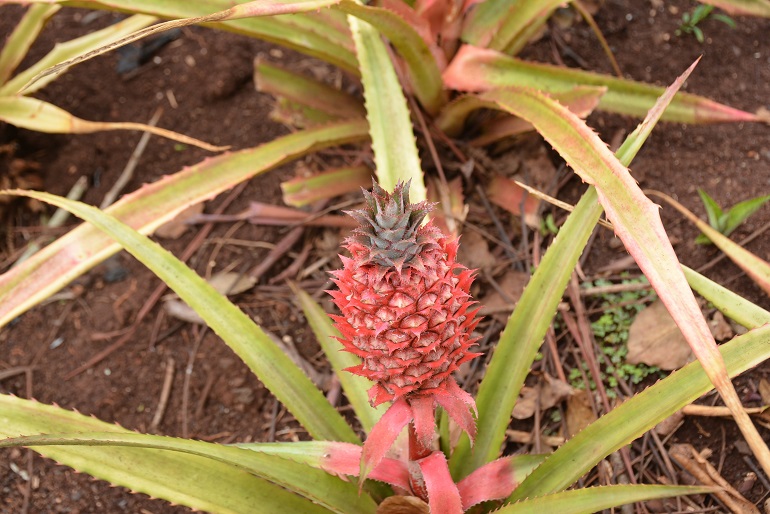Pineapple Fertilization Requirements

This post is also available in:
This post is also available in:
![]() Español (Spanish)
Español (Spanish) ![]() Français (French)
Français (French) ![]() Deutsch (German)
Deutsch (German) ![]() हिन्दी (Hindi)
हिन्दी (Hindi) ![]() العربية (Arabic)
العربية (Arabic) ![]() 简体中文 (Chinese (Simplified))
简体中文 (Chinese (Simplified)) ![]() Português (Portuguese (Brazil))
Português (Portuguese (Brazil))
Nutrition needs of pineapples
Firstly, it is essential to remember that in order to define and cover the fertilization needs of the crop, the grower should consider performing a soil analysis beforehand. This is because different soils have different amounts of nutrients depending, among others, on how acidic they are.
To sustain growth and crop productivity, pineapple trees require nutrients such as nitrogen (N), phosphorus (P), and potassium (K) [1]. These nutrients have a specific role and must be provided to the plant in sufficient quantities and at the proper time. A deficiency in these nutrients may result in problems with fruit weight, shape, and quality. Specifically, pineapple, like all other crops, needs nitrogen because a lack of it limits growth, resulting in dwarf plants and leaf yellowing, which affects the appearance of both the fruit and the stems. Yellow spots on pineapple leaves could be an indication of potassium deficiency.
In general, pineapple fertilizers come in solid and liquid forms and should be used in small quantities regularly for nitrogen and in a few treatments for potassium. Two weeks after planting, farmers incorporate granular fertilizers, while the following fertilization is usually foliar. Foliar fertilization is becoming more crucial in pineapple cultivation due to its lower costs, higher efficiency, and practicability (2). It is important to note that all nitrogen fertilizations should stop two months before bloom induction.
Below you can find some general recommendations (when no soil analysis data are available) for the annual pineapple fertilization schedule in a field with 75,000 trees per hectare (30,400 trees per acre) (3).
- Nitrogen: 600-900 kg/ha (535-803 lb/acre) applied in up to 6 doses.
- Phosphorus (P2O5): 150-300 kg/ha (134-268 lb/acre) during the vegetative stage. These amounts highly depend on the P soil availability.
- Potassium (K2O): 600-1000 kg/ha (535-892 lb/acre) depending on the soil’s acidity, 80-75% during the vegetative stage and 20-25% during the fruit set.
- Sulphur: 50-100 kg/ha (45-90 lb/acre), 5% in the vegetative stage and 25% in the fruiting stage.
- Calcium (CaO): 60-150 kg/ha (54-134 lb/acre), 90% in the vegetative stage and 10% during the fruiting stage.
- Magnesium (MgO): 5 kg/ha (4.5 lb/acre), 75% during the vegetative stage and 25% during fruiting.
- Zinc: 5 kg/ha (4.5 lb/acre ) during the vegetative stage.
- Iron: 8 kg/ha (7 lb/acre) during the vegetative stage.
Fertilization can be done with granulated solid fertilizers and soluble liquid fertilizers (with fertigation or foliar sprays). Each system is explained below.
a) Granular solid fertilizers
- People can apply granulated fertilizers with straightforward tools like spoons or other tools for consistency, but for speed, they also apply granular fertilizers by hand.
- The fertilizers can be placed directly into the planting pits or furrows or as a side dressing.
- Care should be taken when applying granular solid fertilizer so that no matter how the granular solid fertilizer is applied, it should not fall on the top, youngest leaves because it could hurt them.
b) Foliar sprays of soluble (liquid) fertilizers
Foliar sprays of soluble and liquid fertilizers are distributed to the leaves thanks to the pineapple plant’s design and the morphological and anatomical properties of its leaves, which enhance foliar nutrition absorption. This approach is often used to apply N, P, K, Ca, Mg, and micronutrients.
- For foliar application, spray booms attached to backpacks or tanks on the back of tractors are used in large plantations.
- It is important to note that the fertilizer content of the solution should not exceed 10%. Even if the leaves of a mature pineapple plant can manage high concentrations of fertilizer salts well, too much of it in the soil can dry out the roots and hurt or kill them.
- The regular recommended rate of application is 3.5 gal (13.3 liters) per 1,000 plants (4).
References
[1] United States Department of Agriculture. (2018). Pineapple cultivation guide. http://www.micronesialandgrant.org/wp-content/uploads/2018/03/COMFSM-Pineapple-Cultivation-Guide-Verma-2018-Updated-03022018.pdf
[2] Benett C., Boliani A., Teixeira Filho M., Maeda A., Buzetti S. & Andreotti M. (2011). Foliar Fertilization on pineapple quality and yield. Pesquisa Agropecuária Tropical. 41. 248-253. 10.5216/pat.v41i2.8810.
[3] Tessenderlo Kerley .(n.d). Pineapples. http://www.tessenderlokerley.com
[4] Morton, J. 1987. Pineapple In: Fruits of warm climates. https://hort.purdue.edu/newcrop/morton/pineapple.html#Culture
Pineapple History, Uses and Nutritional Value
Pineapples Plant Information and Environmental Requirements
Soil Requirements and Land Preparation for Pineapple
Planting of Pineapple – Pineapple Plant Density
Pineapple Water Needs and Irrigation Systems
Pineapple Fertilization Requirements








































































